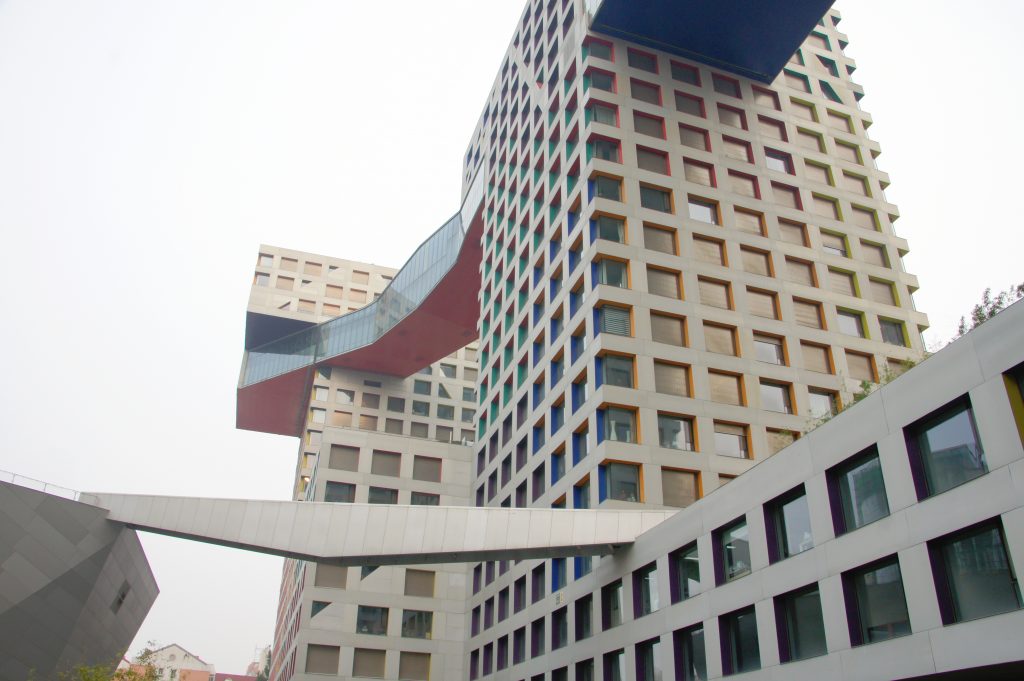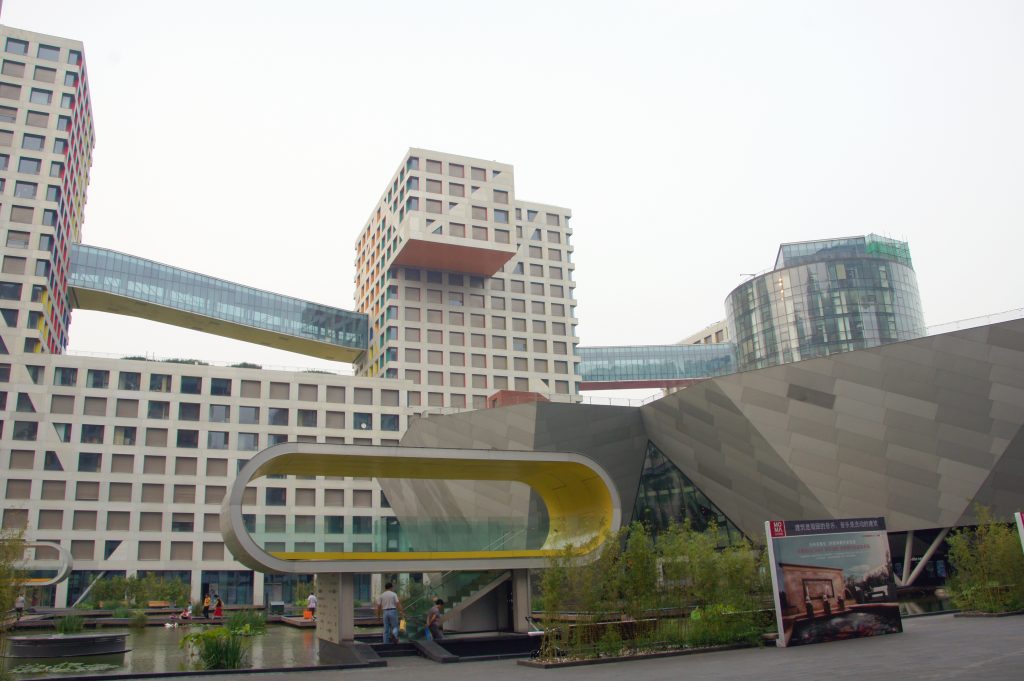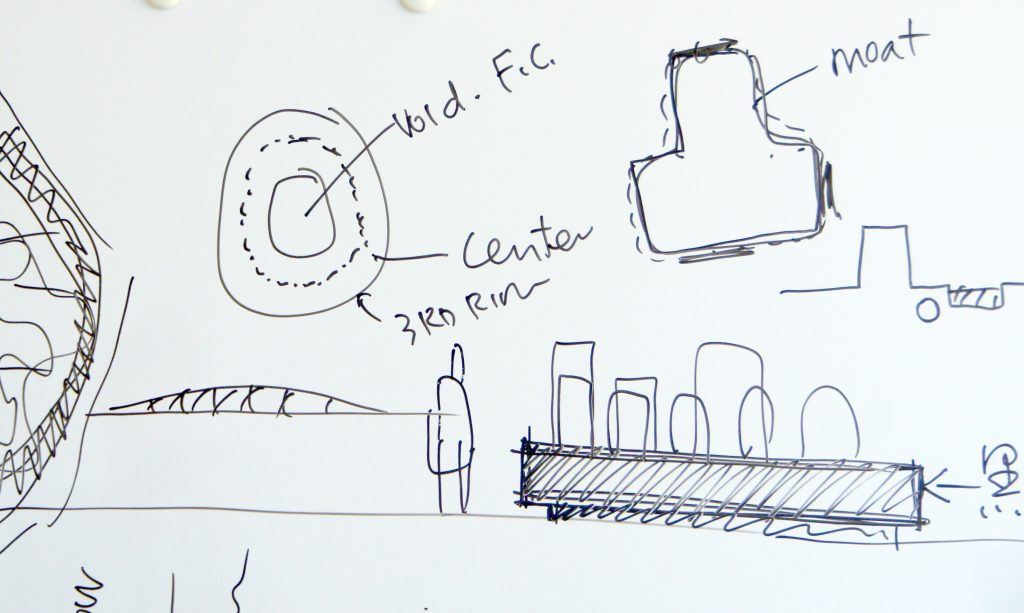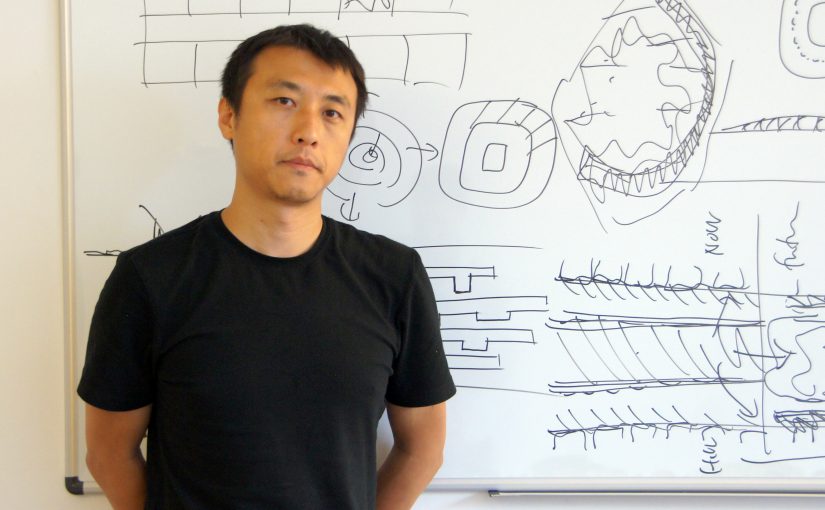A profile of Beijing architect Li Hu, his practice OPEN, and their bold proposal for the 2nd Ring Road in Beijing. Published in FT Rui, August 2011

Having seen it so many times from the freeway, I was excited to finally get a close-up look at Linked Hybrid – no, not a character from a Transformers movie, but the acclaimed mixed-use residential development by Steven Holl Architects, recognisable from its dramatic skybridges and cantilevered volumes; the asymmetric forms and primary-coloured surfaces amplified through their proximity to so many clone towers. The appearance is more than enough to warrant a second glance, but these features turn out to be more than just show, and the development holds many innovative secrets that place it at the forefront of the capital’s building boom. I had come to meet former Holl partner and lead architect on this project Li Hu at the offices of his own 18 strong firm, OPEN Architecture, to talk about this and other recent work.
While very much a fixture in the Beijing Architectural scene, the 38 year old Li’s approach is informed not only through his strong affinity for the city, but also his varied background and experience. Hailing from FuShun, he first moved to Beijing to attend TsingHua University for his undergraduate studies and after gaining a scholarship to Rice University in Houston, moved to the US. This culminated in six years at Steven Holl’s New York office before returning to China and starting Holl’s Beijing outpost, which he ran until 2010.
This return to China brought with it huge challenges – negotiating a vastly different city to that which he had known, whilst also attempting to unite this with his agenda of social cohesion and well-being in urban developments. “My interest in architecture transformed over time. In the states… we were working on beautiful architecture, beautiful details, materiality, light; the typical notion of all that the best architecture can do, but when I moved back to Beijing the city is a totally different place… I start to see social problems and environmental problems and that pushed me into thinking in terms of much larger scale — what can we do? What can we contribute as architects? Not only in terms of – what might be a trendy concept – ‘green’ architecture, but also what can we do to bring a much larger impact to reestablish the urban space and the relationship between people.
These ambitions, closely aligned with those of Holl, led to an incredibly productive 5 years of collaboration. During this time they developed four large projects which have largely set the standard in China in terms of their social, environmental and cultural credentials: Linked Hybrid, Beijing (2003–2009), Sifang Art Museum, Nanjing (2003–2011); Raffles City, Chengdu (2007–2011); and Vanke Headquarters (2006–2009). The latter, Li cites as his favourite – its floating, ‘horizontal skyscraper’ form exemplifying the mantra of mixed-use and diversification in place of strict zones of residential, business and retail use.
This diversity, while perhaps obvious in hindsight, was a severe hurdle when first proposing the Linked Hybrid Project back in 2003. Part of this has to do with the scale of Beijing as a city, but also the scale of residential projects in general: “The scale of the development s down to multi-faceted reasons: political reasons; historical reasons – how China likes big things; there’s a cultural reason and there’s a reason from this moment in history for the new rich to show off. And there is also a reason the development strategy of the government where they want their duty simplified instead of the New York style where the land is cut into tiny little slots comparatively, here they make twenty blocks into one block, so for the government it is very easy – they don’t have to deal with the infrastructure you [the developer] deal with all.”
This in turn has led to a raft of residential mega-developments that are all but indistinguishable – a trend that presents perhaps the Li’s greatest challenge; “There is a complicated cultural and financial reason behind it and I don’t think it is the only way for moving forward, it could be very problematic. But at this moment in history, we have to face reality – how do you still try to create more public space, intimate public space, within this framework of large scale development? And how you can bring a new balance between developments and preserving the nature or maybe even create new nature into this. This is the primary driver behind many of the projects in the office.”

The ‘Linked Hybrid’ concept that informed the design of the complex in which we sit is part of the key to this, but it was not immediately acceptable to the developers: “Hybrid refers to the Hybrid programmes. Back then in 2003 most high-end residential developments are mono functional sleeping types – just pure residential. That was the definition of ‘high end…’ Back then there is only residential or commercial and you can’t mix them up.” It turned out that a trip to New York was crucial in helping the client see what might be possible: “I brought this developer to New York City to where I live… and took them to take subways, which they never had. And I took them to watch a movie… they hadn’t been to a movie theatre for a long long time. Just to try to convince them to please build a movie theatre in the complex… And to show them that a great community doesn’t have to be gated. I was living in Battery Park City, and that’s kind of an odd development in the context of New York city – a large but totally separate, planned community. But I showed them that there’s no gate. Your line of defence is with the doorman in the lobby.”
While being a great fan of utopian mixed use developments, Li is also acutely aware that China has it’s own living model from which to learn: “This model does exist in history. If you look at the old city, the hutongs are mixed use, people only need to step out of their door to buy breakfast – that’s a way of life. So it’s not something strange or culturally new for China, it’s just we try to bring that more ‘liveable’ way of living back to a new development.” This liveability is in part derived from the ‘Porosity’ concept (a favoured Holl term). Li explains: “Porosity is a concept or analogy to imply that things being open, being connected…conceptually connected.. like a sponge… rather than just being a block, it’s more kind of, open.” So what happened here? The entrance I came through was anything but open – unclear access routes, poor signage and unhelpful security guards at the gate. It required a relay of three such guards to escort me to the correct tower entrance. Li, it seems is all too aware. The security guards and concrete faux Ming walls seem to have sprung up from nowhere. He puts these unsympathetic add-ons down to the developer’s concern with what would sell. It is sad that the vision should be marred in this way, but there is much else to celebrate (not least the Geo-thermal wells and other sustainable innovations which enabled the complex to achieve the LEED gold standard) and it seems other developers are slowly getting the message: “…we battled through all the difficulty in terms of the client and the government approval and getting it through and now what’s interesting is that now this model is becoming the norm . Every developer is doing mixed use it’s becoming a trend… it proves people need it this way.”

But Li’s interests are not limited to challenging the Chinese housing strategy. His most extensive proposal to date, and perhaps the one he has been working on the longest (it turns out to be derived from his graduation project) is to be presented at the upcoming Beijing Design Week. This concept concerns the city as a whole and proposes to tackle the overwhelming issues of scale, traffic, community development and green space all in one. Entitled “Second Ring 2049,” it involves the reinstatement of the moat that once ran along the city wall, and turning what is now a chaotic thoroughfare into a green belt running round the city. Li explains: “What happens now is that we have this quasi-freeway. But the freeway travels at the local speed. And then you have the buildings from both sides. And this space [at the sides] is junk space, almost leftover space and there is no life here, no commercial activity, it’s just wasted . So the proposal is to move the traffic to the perimeter in two streets.” While such a scheme taken at face value may seem absurdly simplistic and/or impractical, Li has a very convincing argument for the increased focus on this area: “One interesting thing about Beijing is the illusion that there is a centre. I see Beijing differently. I see Beijing like a doughnut. The whole centre of Beijing functions as a doughnut. The void is the Forbidden City and roughly the centre ends around the third ring…. So Beijing centres on the second ring – the second is the centre.” This description resonates with anyone who knows the city, and this doughnut concept is something that Li feels is desperately needed in order to distinguish the capital from its rivals both in China and abroad: “I deeply believe that if we do this in Beijing, this will put us on the map. The government is very eager to do something – they are frustrated and they are trying very hard to figure out a way…to put us on the Global Map. I believe they probably understand by now that by building skyscrapers, building an even larger CBD is not the way out. It does not make Beijing special, unique. It only makes us the same as any other cities. Wuhan is building skyscrapers in the CBD; Guangzhou, Shanghai, Pudong – they are all trying to be Hong Kong. But this – [the Second Ring Road proposal] makes Beijing totally unique. While the proposal has many fans, it seems that many are also fixated on the capital’s current unhealthy dedication to the car. “They all love the idea, but often their first reaction is ‘what about the traffic?’ (laughs). That’s why we didn’t call this project 2012, we called it 2049. In 2049 the whole world will have to travel differently; we cannot always everyday drive a car. It’s impossible. There’s 4 million cars in the city… the reason we set it in 2049 is that I believe that by 2049 we will not all be driving any more.” Li believes that the concept could be realized in as little as five years from beginning to end, but despite his enthusiastic selling of the concept, he accepts that it may never happen. Either way, it is part of an ongoing programme of experiments and proposals through which his firm can start to re-evaluate and help others understand how the city might better evolve: “I must confess, I do not have answers for the solution for China, but that’s why I decided to do OPEN Architecture, where I see this as experiment for years to come to look for answers, testing out ideas with each project and we’re excited to work on many different typologies right now: schools… residential buildings… high-rise… But we also do very very small projects. One of my strategies about big-scale projects…, that I learned from Steven Holl, is that you need to start with a clear, big concept and then you need to focus on very small details. So these two ends are very important… the macro-scale and the micro-scale.”
As I leave the office and walk through the complex at ground level, one starts to get a sense of what Li is describing. Away from the unintended walls, barriers, gates and guards, the development does retain a friendly and comfortable atmosphere, with a duck pond overlooked by a bookshop and café, elsewhere there is even a cinema and there are plenty of people enjoying the space as intended. It is a shame that a visitor is unlikely to stumble across this, as one might in London or New York. But in Li’s new vision for the Second Ring, Linked Hybrid would lie close to the Doughnut’s centre. So maybe there is hope yet.
Second Ring 2049 will be presented during Beijing Design Week 26.09.11 – 03.10.11http://www.bjdw.org
Links:
Images:
LiHu_Linked_Hybrid06.JPG
Li’s image of the ‘doughnut concept.’ Photo: Ben Hughes
LiHu_Linked_Hybrid10.JPG
Linked Hybrid Development, Beijing, by Stephen Holl Architects. Photo: Ben Hughes
LiHu_Linked_Hybrid11.JPG
Linked Hybrid Development, Beijing, by Stephen Holl Architects. Photo: Ben Hughes
LiHu_Linked_Hybrid02.JPG
Li Hu. Photo: Ben Hughes
LiHu_Linked_Hybrid05.JPG
Li Hu and Ben Hughes. Photo: Sigmund Lerner
